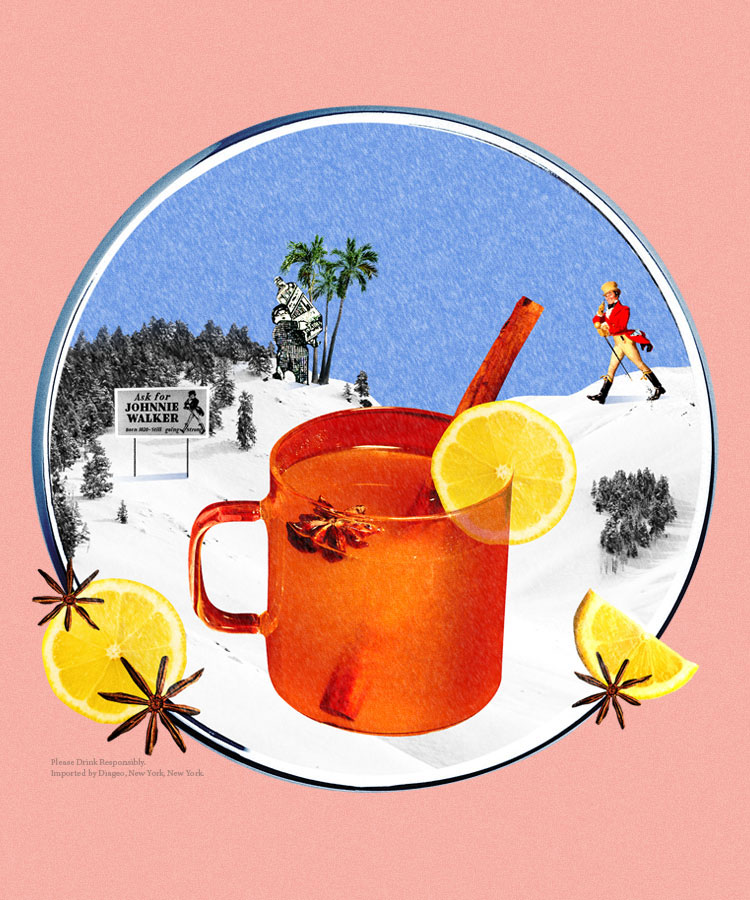
This article is part of a cocktail history series, sponsored by Johnnie Walker. Discover more about classic Scotch cocktails here!
The Hot Toddy is a cocktail so self-evident in construction it seems impossible to credit any one person with its recipe creation. It just sort of came to be. Take a good glug of Scotch, pour some hot water over it, add some lemon and maybe a good spoonful of sugar if you have it. Drink and let the warmth envelop you as the chilly fall becomes a brutal winter.
What is known is that, by the 1700s, it was being sipped fervently in Scotland, where the weather is often quite dreich as they say. It’s thought the hot water and sugar may have also been used to mute the smoky spirit a bit for drinkers incapable of handling a robust Scotch as is.
“The thick texture of the spirit means that the Toddy will feel rich and silky on your palate as it goes down,” writes drinks historian David Wondrich, while noting that the drink was, in fact, known as a “Hot Scotch” when it first started appearing on American shores in the 1880s.
That makes sense, but the name “Hot Toddy” is a bit harder to pin down. Many attribute it to being a spin-off of India’s own “toddy,” a wine made from the sap of palm trees, and well known by British colonialists. This, however, seems somewhat unlikely— palm tree sap has never been a common ingredient in the Hot Toddy. What India did contribute, however, was an active spice trade, which many theorize is how ingredients like cinnamon, nutmeg, cloves, allspice, and ginger came to be “mulled” into early Toddy recipes.
Another theory links the drink’s etymology with the main water supply to Edinburgh at the time, Tod’s Well. This “Todian Spring water” may have been the integral ingredient in making a Toddy officially a “Toddy.”
Today, water taken from the faucet and heated up in an electric kettle will do you just fine. And, while remaining a seemingly simple drink, the Hot Toddy is hardly uninspiring — in fact, its basic template allows both bartenders and at-home enthusiasts to customize and personalize it any way he or she likes it.
One can opt for a smokier single malt or a more balanced blended Scotch; the latter will integrate much better, offering soft barley notes that pair well with the sweetener. With that, you can use raw sugar, honey, or perhaps a more offbeat selection like maple syrup. A swath of lemon peel is the most common way to inject a little acid to the drink, but orange or even a splash of vinegar work well, too. Any spice that screams “winter” is a swell addition to the mix.
Today, just about every country in the world has its own version of a Hot Toddy. While hot water would seem to be the one immutable ingredient, modern bartenders across the globe now swap in everything from black tea to pu-erh to hot sake to more fortified versions using warmed cider. As many have come to realize, the Hot Toddy is less about exactitude, and more about the feeling. As Wondrich believes:
“It exists to light and fuel a little, glowing furnace somewhere between your heart and your liver.”
Ingredients
- 1 1/2 ounces Johnnie Walker Black Label
- 1/2 ounce lemon juice
- 1/2 ounce honey
- 3 ounces hot water
Directions
- Combine all the ingredients in a glass.
- Stir lightly to mix.
- Add star anise and cinnamon stick to garnish.
This article is sponsored by Johnnie Walker. Keep walking.
![]()
